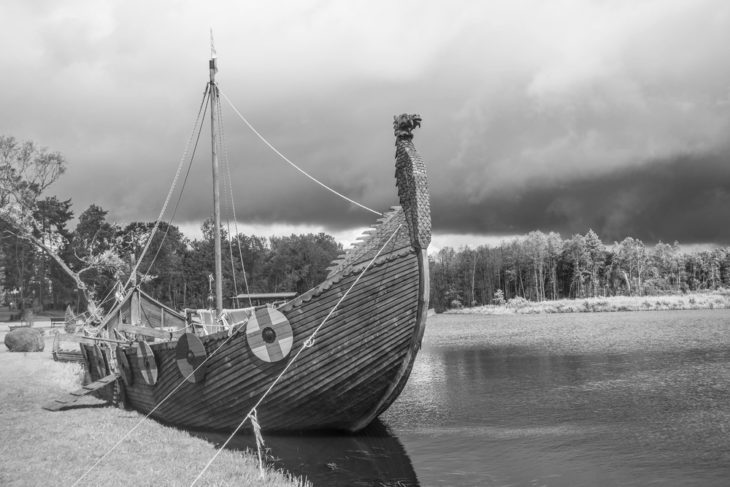Viking Longboats and Nordic Timber Work

The Vikings were the dominant power in Europe for three terrifying centuries, striking fear into the heart of medieval civilisations across the continent from AD 800-1100. The sight of square sails and dragon-headed prows appearing on the horizon brought mass hysteria, with atrocities, raids and enslavement wherever the Nordic warriors landed.
One of the reasons the Vikings were so successful was their superior mobility. Their sleek and speedy longboats, with their characteristic shallow-draft hull, made it possible to navigate the North Sea and Europe’s many rivers and waterways and appear almost out of nowhere. This element of surprise was their greatest weapon and made them an unstoppable force in medieval warfare, politics and trade.
How were Viking longboats made?
The secret of the Vikings’ ships lies in their unique construction. Viking longboats were ‘clinker’ built, a technique that used planks of wood that overlap at one edge and are riveted together. The ships were then made watertight by filling the spaces between the planks with tarred wool or animal hair. Wood such as ash, elm and pine was used, but generally, the greatest warships were made from oak due to its unrivalled strength.
This clinker shipbuilding technique worked from the outside in, with the hull of the ship built first and the frame then created inside it. In a clinker-built boat, only the best wood can be used. That’s because the overlapping wood needs to add strength to the boat but also has to be light and transmit forces efficiently between the propulsion, the oars and the sail.
The tools used to build these spectacular ships were remarkably simple. In fact, it’s said that an entire Viking longboat could be made with nothing more than an axe. Using a broad axe rather than a saw, expert woodworkers would split oak tree trunks into long, thick planks. The boards would then be fastened with iron nails to the keel and each other. Augers would create holes for rivets, and trenails and profile irons were used to carve channels for caulking and make decorative marks. Wooden mallets, knives and chisels were also commonly used.
Key parts of the Viking longboat
Prow and figurehead – Five broad planks on each side of the ship extended all the way to the curving stem posts and stern posts to create the great curved prow (front) of the Viking ship. This was often decorated with a figurehead, which was typically a carving of a dragon or a snake. These figureheads were created by craftsmen and were put up when the ship neared land to frighten the spirits of the countries they were raiding.
Hull – The hull of a Viking longboat was built using the shell-first sequence discussed above, before adding strakes and fitting internal timbers as the last stage. This made the hull much lighter and more flexible than ships of the same size, making them capable of sailing in much shallower waters. The hull was made from dry or dead wood to prevent deformations during the construction.
Oars – Viking longboats were powered by huge sails and long oars, with the oars used when there was little wind or when the crew planned to mount a surprise attack. The crew would sit backwards and propel the vessel with the long oars that were looped to rowlocks made out of crooked oak. The oars were a different length according to where they would be used on the ship.
Mast and sail – The sails of Viking ships were made from thin strips of rough wool cloth that were sewn together to create large square sails that allowed the lightweight ships to travel rapidly across the sea. Viking ships were rigged with a single mast which was up to 16 metres tall. The mast was placed in the middle of the ship and could be removed and stored horizontally when not in use.
Shields – Viking sailors kept their large, round, wooden shields hanging over the side of the boat as they travelled. Their shields were made from planks of linden, pine, spruce or fir tree wood that was butted together and was sometimes reinforced with iron.
Rudder – A longboat’s rudder consisted of a large piece of timber around 2.4 metres in length that included a rounded wooden block with a central hole for a rope. This rope was fastened inside the hull with enough slack to let the rudder pivot. In shallow water, the rope was slackened and the rudder head pulled up so the boat could still navigate effectively.
Keel – The keel is made of long pieces of oak that have a V or a T shape so the planks of the hull can be joined to it. Two pieces of curved wood are attached at the front and back of the keel. These are ‘grown timbers’, which is wood that has been selected because it approximates the shape required. The keel is then joined to the stem and stern posts by wooden pegs and is ready to have the planks of the hull attached to it.
Viking strength oak for your next project
At Thorogood, we supply a wide range of premium, high-quality timbers including the hard-wearing oak used by Vikings. Whatever your project, we can supply the wood to meet your requirements. Please get in touch to discuss your project with our team.
Blog | 7 years AGO